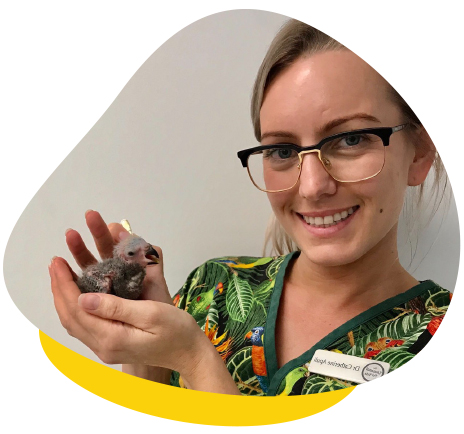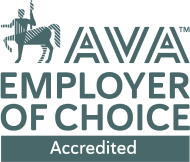Most companion avian species are ‘altricial’, where newly hatched chicks lack feathers, have closed eyes and limited mobility. Unlike ‘precocial’ species, these babies are dependent on parental care for survival, which is independent after birth/hatching.
Where possible, baby birds should be parent-reared for the first 2-3 weeks of life when they require up to 1-2 hourly feeding, receive beneficial bacteria and socialisation. Situations that necessitate hand-rearing include where the chick has been orphaned, rejected, neglected or injured by a sibling or parent.
This general guide is intended for hand-rearing companion parrots and passerines. Please note that wildlife should only be hand-reared by experienced and licensed wildlife carers.
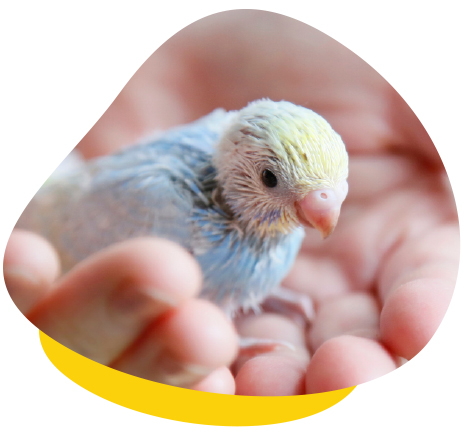
What to Feed Baby Birds?
Baby birds should be fed a good quality commercial hand rearing formula. The formula should be made up fresh for each feed, and leftovers should be discarded as stored formula grows bacteria quickly, even with refrigeration.
The formula should be 39-41°C when fed. It should be made up with boiling or hot water, thoroughly mixed and allowed to cool to this temperature. The formula’s temperature should be measured with a thermometer prior to feeding. Please note that gauging temperature on the wrist is inaccurate and should be avoided.
Improper feed temperatures can lead to a number of health issues in baby birds. Cold and stale formula can cause crop infections and crop stasis, whereas hot formula can cause crop burns. For this reason, it is not recommended to heat formula in a microwave as this can cause hotspots that lead to crop injuries.
Feeding Technique and Instruments
Required feeding instruments include a syringe to measure the feed volume and feeding spoons (which have the sides bent upwards). Crop needles/tubes should not be used for hand-rearing as the chick should readily take food from their mouth. If crop feeding is needed, people with specific training and experience should only ever perform this.
It is important that feeding instruments are disinfected and cleaned with hot soapy water between feeds. Feeding instruments should also not be reused between clutches without disinfection as this can spread disease.
Before feeding starts, the chick must show a strong feeding response where they shake or bob their head vigorously. During this time, the airway closes, protecting the chick from food inhalation (aspiration).
The feeding instrument can then be introduced to the front of the mouth and a reasonably large amount of formula can be steadily given. Feed until the bird’s feeding response stops or the total feed volume has been given. Do not feed the bird if they aren’t showing a feeding response as they could inhale the food.
After feeding, you will notice that the crop (the distended portion of the oesophagus at the base of the neck) will enlarge with formula. This should steadily drain and be nearly completely empty around 1-4 hours following a feed depending on the species you are hand-raising and the amount fed.

How Much to Feed?
The following is a general feeding guide. Please note, however, there are considerable differences between species, so please consult with your avian veterinarian or an experienced hand-raising professional about your individual situation.
Generally, baby birds should be fed 6-10% of their body weight at each feed. Each baby should be weighed in the morning before their first feed to calculate the appropriate volume of formula. It is a good habit to keep records of the bird’s weight and the volume of feeds taken to ensure this is steadily increasing throughout the hand-rearing process and to identify problems early.
Typically, newly hatched chicks less than a week old require 1-2 hourly feeds. Featherless chicks with their eyes closed require 3-4 hourly feeds. Chicks with their eyes open and pin feathers emerging need 4-6 hourly feeds. When chicks start to begin fledging (learning to fly) and are eating some solids, feeds can be given less often.
Please note that when birds begin fledging, they may reject or eat less formula for a few days, but will then re-accept feeds. It is normal for fledglings to lose up to 10% of their body weight during this period.
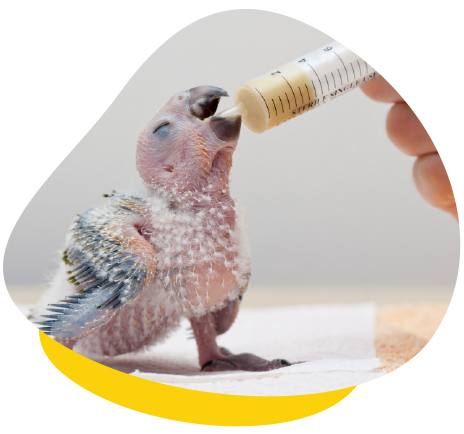
Weaning
Weaning is the process when birds transition from being fed liquids to accepting solid foods they will consume as an adult. At weaning, young birds should be offered a wide variety of foods they will be expected to eat as an adult, such as pellets, vegetables, leafy greens, fruit, sprouts and some seed.
Weaning age differs between species, with a list of more common species fledging and weaning ages below. They should also be offered a shallow water bowl. Please see our species care sheets for further diet recommendations.
Offering a variety of foods on a flat dish encourages the bird to play with and try different foods, which will increase their food options as an adult. Ensure the foods offered are fresh and changed at least daily.
As the bird starts consuming solid foods, the frequency and volume of formula feeds can be reduced, usually over 2-3 weeks (some birds take much longer than this). Feeds in the middle of the day should be removed first, followed by the morning feed and lastly, the evening feed towards the end of weaning.
As before, it is important to monitor the bird’s weight each morning as well as continue to weigh them the week following weaning, with a 5% weight loss during this period considered acceptable.
Weaning birds onto a correct diet is essential as this sets them up for good long term health by avoiding diseases associated with malnutrition.
| Species | Fledging age (days) | Weaning age (days) |
| Budgerigar | 30 | 30-40 |
| Lovebird | 35-40 | 45-55 |
| Cockatiel/weiro | 35 | 40-50 |
| Conure | 50 | 55-75 |
| Rainbow lorikeet | 55-60 | 60-70 |
| Indian ringneck parakeet | 50 | 70-90 |
| Alexandrine parakeet | 50 | 85-100 |
| Quaker parakeet | 40-50 | 50-60 |
| Pink and grey galah | 42-49 | 85-95 |
| Eclectus parrot | 72-80 | 80-90 |
| African grey parrot | 75-85 | 100-120 |
| Sulphur-crested cockatoo | 63-90 | 120-150 |
| Blue-fronted amazon | 55-65 | 90-120 |
| Blue and gold macaw | 90-100 | 90-110 |
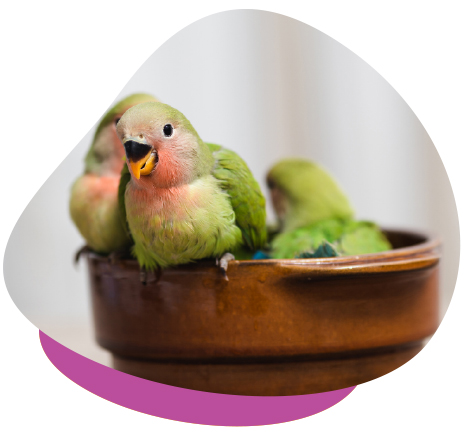
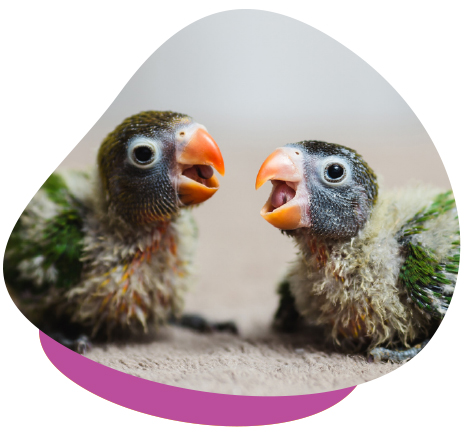
Housing
Chicks should be housed in small, dark, clean and well-ventilated containers on paper-based substrates that provide good grip, such as paper towel or recycled newspaper pellets.
Newly hatched chicks should be kept at an ambient temperature of 32°C (depending on the species). As a general guide the ambient temperature can be reduced by 1°C every week until the chick is fully feathered, when active heating can stop.
To prevent abnormal skeletal development, the chick needs to be confined in a small space until it reaches fledgling age, when it can then be allowed to exercise and placed in a larger enclosure. Enrichment activities should also be provided at this stage of development to stimulate the bird’s curiosity and encourage foraging behaviours.
When to Visit the Vet?
If your baby bird is experiencing any of the following problems, we recommend a health assessment with one of our avian veterinarians:
- Vomiting and regurgitation
- Diarrhoea
- Delayed crop emptying or a persistently enlarged crop
- Poor or absent feeding response
- Losing or not gaining weight
- Abnormal development of the legs, wings or posture
- General signs of illness, e.g. inappetence, lethargy, closing eyes, hunched and/or fluffed appearance
If you have any further questions on hand-raising baby birds, please don’t hesitate to get in touch with your local Unusual Pet Vets team.
